
by Deep Green Resistance News Service | May 12, 2017 | Education, Indigenous Autonomy
Featured image: Indigenous women carry the banner of the VIII Pan Amazonian Social Forum (FOSPA) during the opening march from downtown Tarapoto to Universidad San Martin on April 28. Photo: Manuela Picq
by Manuela Picq / Intercontinental Cry
Ever since European colonial powers started disputing borders on its rivers in the seventeenth century, the vast Amazon rainforest—known simply as Amazonia—has been under siege.
Amazon Peoples always resisted the colonial invasion, even after the borders were ultimately settled with the Amazon rainforest getting divided into the territories of nine states. They’ve had no choice. After all, the insatiable lust for ‘wealth at any cost’ did not lessen with time; the siege continued through the nineteenth century, in part with the rubber boom that gave way to the automobile boom.
The attack rages on even now, with the intensive push to extract everything the Amazon holds including oil, minerals, water, and land for agriculture and soy production.
Nations states are leading the land-grab, fostering environmental conflicts that kill nature defenders (most of them indigenous), displace communities, and destroy rivers for megaprojects. The organization Pastoral da Terra estimates that half a million people are directly affected by territorial conflicts in the Brazilian Amazon. About 90% of Brazilian land conflicts happen in Amazonia; 70% of murders in land conflicts take Amazon lives.
That is why people responded to “the call from the forest,” or “el llamado del bosque” in Spanish. This was the motto of the VIII Pan-Amazonian Social Forum, or Foro Social Pan Amazónico (FOSPA), that just gathered 1500 people in the town of Tarapoto, Peru.
The VIII Pan Amazonian Social Forum in Tarapoto, Peru

Photo: Manuela Picq
FOSPA is a regional chapter of the well-established World Social Forum. It is based on the same model that brings together social movements, associations and individuals to find alternatives to global capitalism. From April 28 to May 1, indigenous peoples, activists, and scholars from various parts of Amazonia got together in the campus of Universidad Nacional San Martin.
FOSPA is an important space, not only because the region is at the forefront of the climate crisis but also because it represents 40% of South America and spreads across nine countries—Brazil, Bolivia, Peru, Ecuador, Colombia, Venezuela, Guyana, Suriname, and French Guyana. The 370 indigenous nations in the region are an increasingly smaller part of a booming Amazon population that surpasses 33 million.
This VIII forum was well organized in an Amazon campus with comfortable work space and the shade of mango trees. In the absence of Wi-Fi, participants gathered around fruit juices and Amazon specialties baked in banana leaves at the food fair. The organizing committee, led by Romulo Torres, was most proud of creating the new model of pre-forum. For the first time, there were 11 pre-forums organized in 6 of the 9 Amazon countries to prepare the agendas.
The forum started with a celebratory march through Tarapoto. During three days, participants discussed the challenges of extractive development and land grab across the region. There was in total nine working groups organized around issues such as territoriality, megaprojects, climate change, food sovereignty, cities, education and communication.

During the opening march in defense of Amazonia, Elvira and Domingo, from Ecuador’s Confederation of Indigenous Nationalities of the Amazon (Confeniae) walk along Carlos Perez Guartambel, from the Andean Network of Indigenous Organizations (CAOI) and Ecuador’s Confederation of Kichwa Peoples (Ecuarunari). Photo: Manuela Picq
“Development is the problem”
Speakers strongly criticized models of development based on extractive industries. “Development is the problem, not the solution,” said Carlos Pérez Guartambel, from the Andean Network of Indigenous Organizations (CAOI) and the Confederation of Kichwa Peoples of Ecuador (ECUARUNARI).
Speakers blamed the political left for being equally invested as the right in extractive development, destroying life in the name of development. Toribia Lero Quishpe, from the CAOI and the Council of Ayllus Markas of the Quillasuyu (CONAMAQ) argued that this investment in capitalist gains corrupted the government of Evo Morales, who licensed over 500 rivers to multinational companies.
Gregorio Mirabal, from the Indigenous Network of the Amazon River Valley (COICA) and Venezuela’s Organization of Indigenous Peoples of the Amazon (ORPIA) denounced a massive land grab by the state in the Orinoco region. He said the government is licensing land to mining companies from China and Spain to promote “ecological mining.” Indigenous populations, in turn, have not had a single land title recognized in 18 years and are denied rights to prior consultation.
Ongoing French colonization in Amazonia

A working group discusses the decolonization of power and self-government in Peru. Photo: Manuela Picq
One of the working groups focused on the decolonization of power; French Guyana being the last standing colonial territory in South America.
Rafael Pindard headed a delegation from the Movement for Decolonization and Social Emancipation (MDES) to generate awareness about Amazon territories that remain under the colonial control of France.
Amazon forests constitute over 90% of French Guyana. Delegates described laws that forbid Indigenous Peoples to fish and hunt on their ancestral territories. They explained the mechanisms of forced assimilation—the French state refuses to recognize the existence of six Indigenous Peoples, claiming that in France there is only one people, the French.
The Women’s Tribunal

The forceful participation of women was one of the forum’s most inspiring aspects. Amazon women held a strong presence in the march, plenary sessions and held a special working group on women.
The highlight was the Tribunal for Justice in Defense of the Rights of Pan-Amazonian and Andean Women. Four judges convened at the end of each day to listen to specific cases of women defenders. They heard individual as well as collective cases. Peruvian delegates presented the case of Maxima Acuña, a water defender from the Andean highlands of Cajamarca who faces death threats. Brazilian representatives from Altamira presented the case of the Movement Xingu Vivo para Sempre, which organizes resistance against the Belo Monte Dam.
The Women’s Tribunal also heard cases from across the continent. Liliam Lopez, from the Confederation of Indigenous Peoples of Honduras (COPINH), presented the emblematic case of Berta Cáceres, assassinated in 2016 for leading the resistance in defense of rivers. Delegates from Chile presented the case of Lorenza Cayuhan, a Mapuche political prisoner jailed in Arauca for defending territory and forced to give birth handcuffed.
Initiatives
Many working groups called for a paradigm shift to move away from economic approaches that treat nature as a resource. Participants defended indigenous notions of living well, or vivir bien in Spanish.
There were many initiatives presented throughout the gathering. The working group on food sovereignty proposed to recover native produce and exchange seeds, for instance, through seed banks.

The final proposals of all working groups hang in the main tent allowing participants to add suggestions before the elaboration of the final document. Photo: Manuela Picq
Delegates from the Confederation of Indigenous Nationalities of the Ecuadorian Amazon (CONFENIAE) and the organization Terra Mater presented a collaborative project to protect 60 million acres of the mighty Amazon River’s headwaters – the Napo, Pastaza, and Marañon River watersheds in Ecuador and Peru. The Sacred Headwaters project seeks to ban all forms of extractive industries in the watershed and secure legal titles to indigenous territories.
Wrays Pérez, President of the Autonomous Territorial Government of the Wampís Nation (GTAN Wampís) explained practices of indigenous autonomy. The Wampís, who have governed their territories for seven thousand years, have successfully preserved over a million hectares of forests and rivers in Santiago and Morona, Peru. The Wampís Nation designed its own legal statute based on Peruvian and international law, including those protecting the collective rights of Indigenous Peoples.
Amazon communication

Radio Nave covered FOSPA, organizing live interviews and debates with participants. Photo: Manuela Picq
Many venues emphasized the importance of Amazon communication. All workshops and plenary sessions were transmitted live through FOSPATV and remain available on FOSPA’s webpage.
Community radios and medias covered the forum and interviewed participants, such as Radio Marañón, Radio La Nave, and Colombia’s Radio Waira Stereo 104 (Indigenous Zonal Organization of the Putumayo OZIP).
Documentary films played in the evenings, followed by discussions. The Brazilian documentary film “Belo Monte: After the Flood” played in Spanish for the first time, followed by a debate with people affected by hydro-dams in the Brazilian and Bolivian Amazons. Other films presented include “Las Damas de Azul”, “La Lagrima de Aceite” y “Labaka.”
The Tarapoto Declaration

A plenary assembly announces the final Declaration of Tarapoto, May 1 2017. Photo: Manuela Picq
The forum closed with the Carta de Tarapoto, a declaration in defense of life containing 24 proposals. The declaration collected the key demands of all working groups. It demands that states respect international indigenous rights and recognize integral territories. It invites communities to fight pervasive corruption attached to megaprojects and suggests communal monitoring to stop land-grabbing.
The declaration stresses the shared concerns and alliances of Amazonian and Andean peoples, explicitly recognizing how the two regions are interrelated and interdependent. It denounces state alliances with mining, oil, and hydroprojects. It defines extractive megaprojects as global capitalism and a racist civilizing project.
It echoes FOSPA’s intergenerational dimension, celebrating elders as a source of historical knowledge to guide the preservation of Amazon lifeways. Youth groups, who had their own working group, demanded that states recognize the rights of nature.
Women concerns are the focus of four points. In addition to making the Women’s Tribunal a permanent feature of FOSPA, the declaration calls for the end of all forms of violence against women and the recognition of women’s invisible labor. It asks for governments to detach from religious norms to follow international women rights.
In closing, the declaration expresses solidarity with peoples who live in situation of conflict, whose territories are invaded, and who are criminalized for defending the rights of nature.
It is in that spirit that the organizing committee decided to hold the next FOSPA in Colombia. Defenders of life are killed weekly despite the peace process, revealing a political process tightly embedded in the licensing of territories to extractive industries like gold mining.
The Colombian Amazon is calling. May it be a powerful wakeup call across and beyond the Amazons.
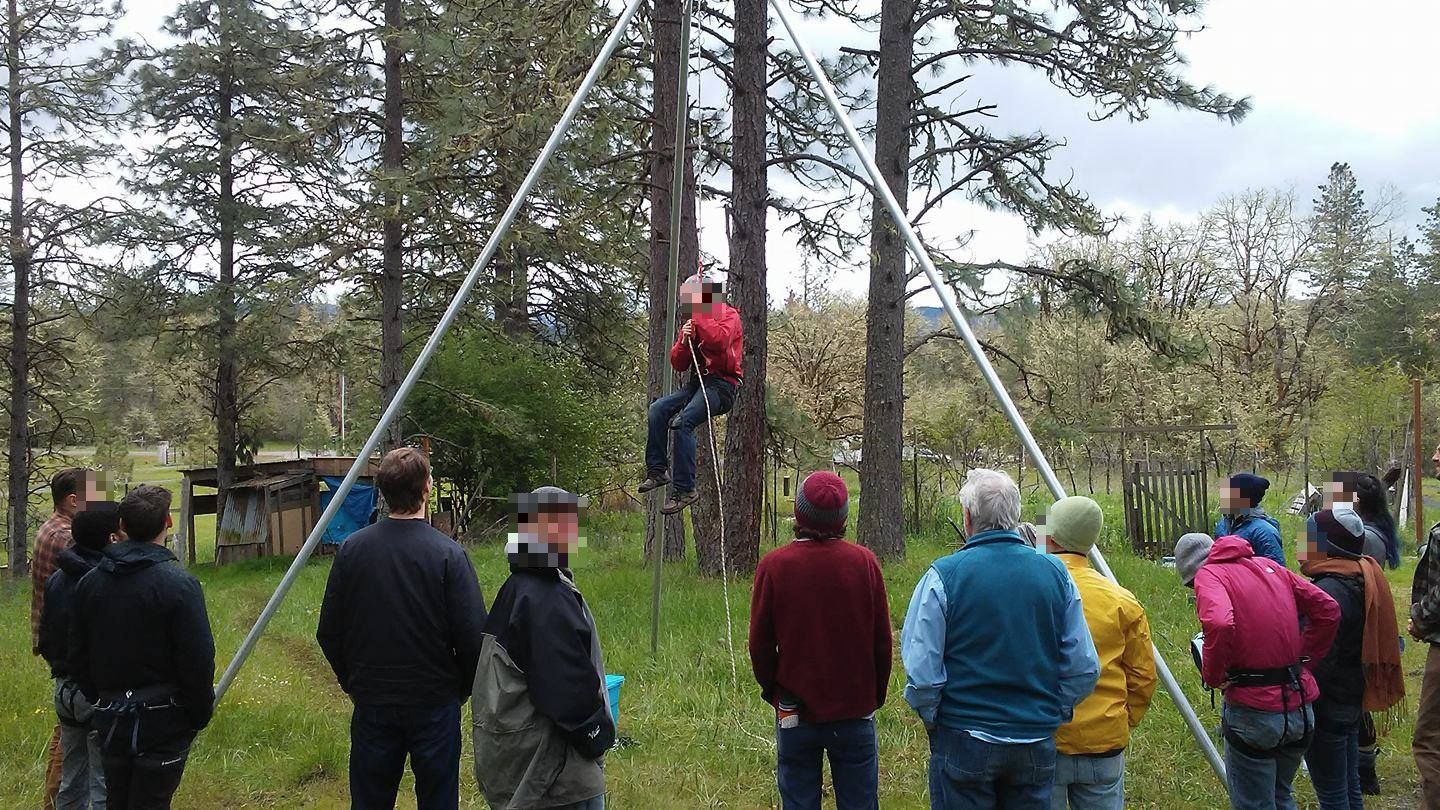
by DGR Editor | May 2, 2017 | Education
by Deep Green Resistance Eugene
Over Earth Day weekend, Deep Green Resistance members in Oregon hosted an advanced direct action training in rural western Oregon.
About 45 people attended from several surrounding states.
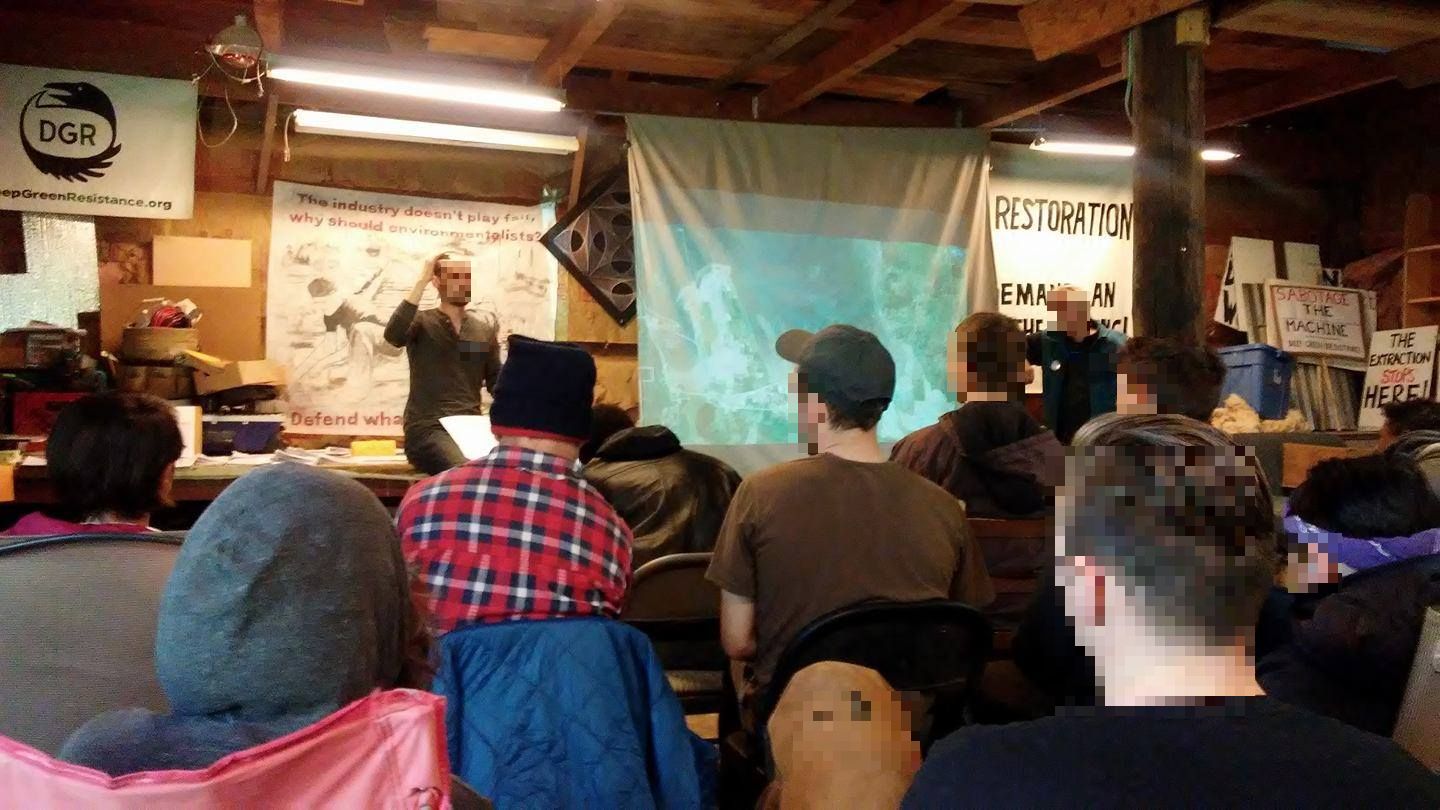
This workshop broke down critical factors and possible improvements for various recent and historical resistance actions and campaigns.
The training began with several anti-oppression sessions to help foster an equitable and safe environment for facilitators and participants, especially for people of color, women, indigenous people, and members of other oppressed and marginalized groups. These sessions, which included an introduction to radical feminism and a group activity around understanding privilege, aimed to inform the interpersonal dynamic and content of the training. This is also to help facilitate a more inclusive and comfortable organizing experience in our communities.
Other training sessions included:
• Campaign strategy
• Target selection
• Case studies in two recent direct actions from people involved in them
• Analysis of critical factors in other recent and historical resistance campaigns / actions
• Scouting for action
• Know your rights and legal briefing
• Art and resistance
• Media
• Various hard skills for blockades and direct action
• Communications and digital security
• Affinity groups
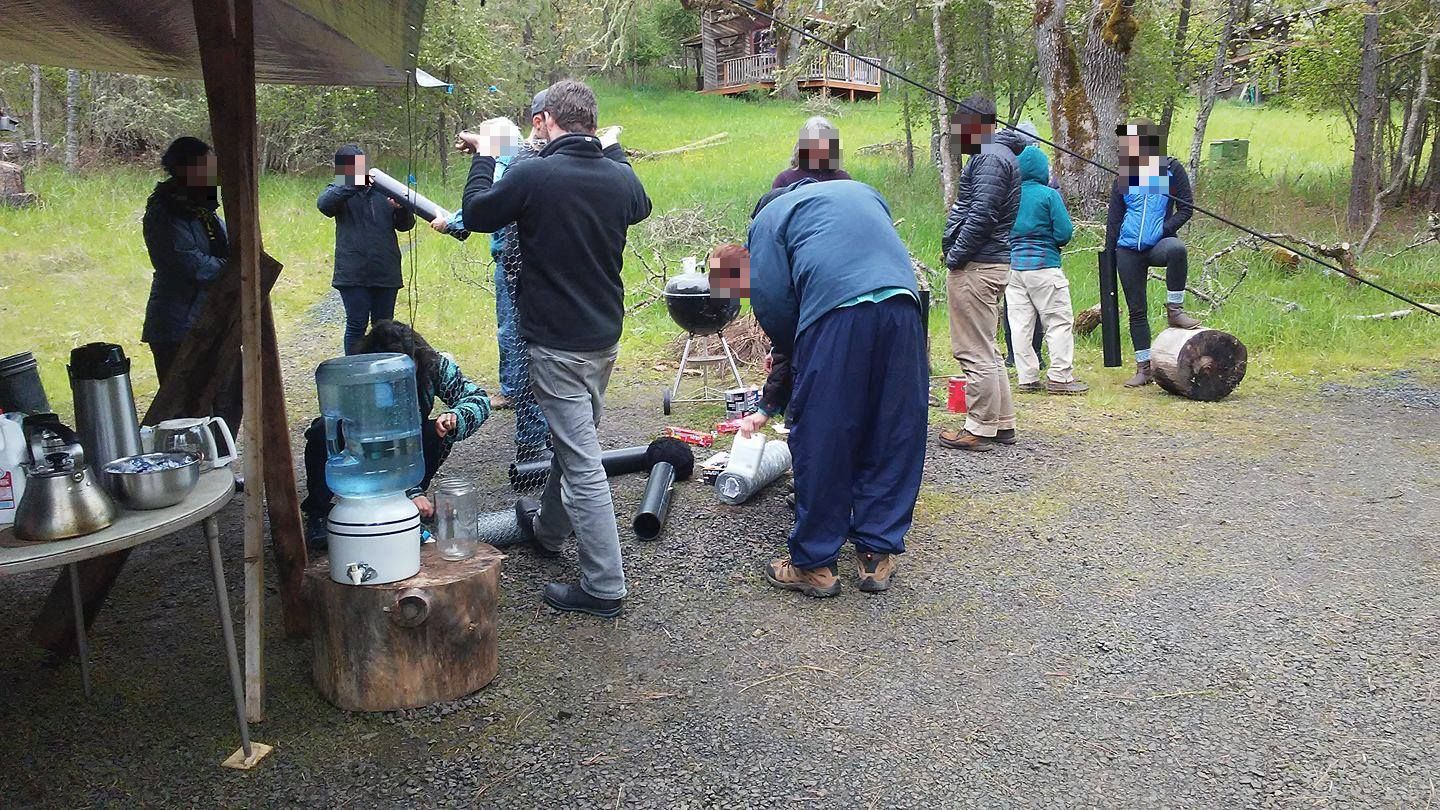
Experimentation with building materials for blockades.
Trainings like this play an important role in developing two critical elements in effective resistance: community and skills.
This sort of event would be impossible without financial support. To everyone who donates to Deep Green Resistance, is a monthly sustainer, or purchases gear from our website—thank you!
A few comments from attendees:
“Thank you… for such a comprehensive training in just a few days!”
“I considered not coming when I saw some militant photos on the DGR website, but I’m so glad I did. This training really debunked the myth of resistance activists being casually militant and violent people.”
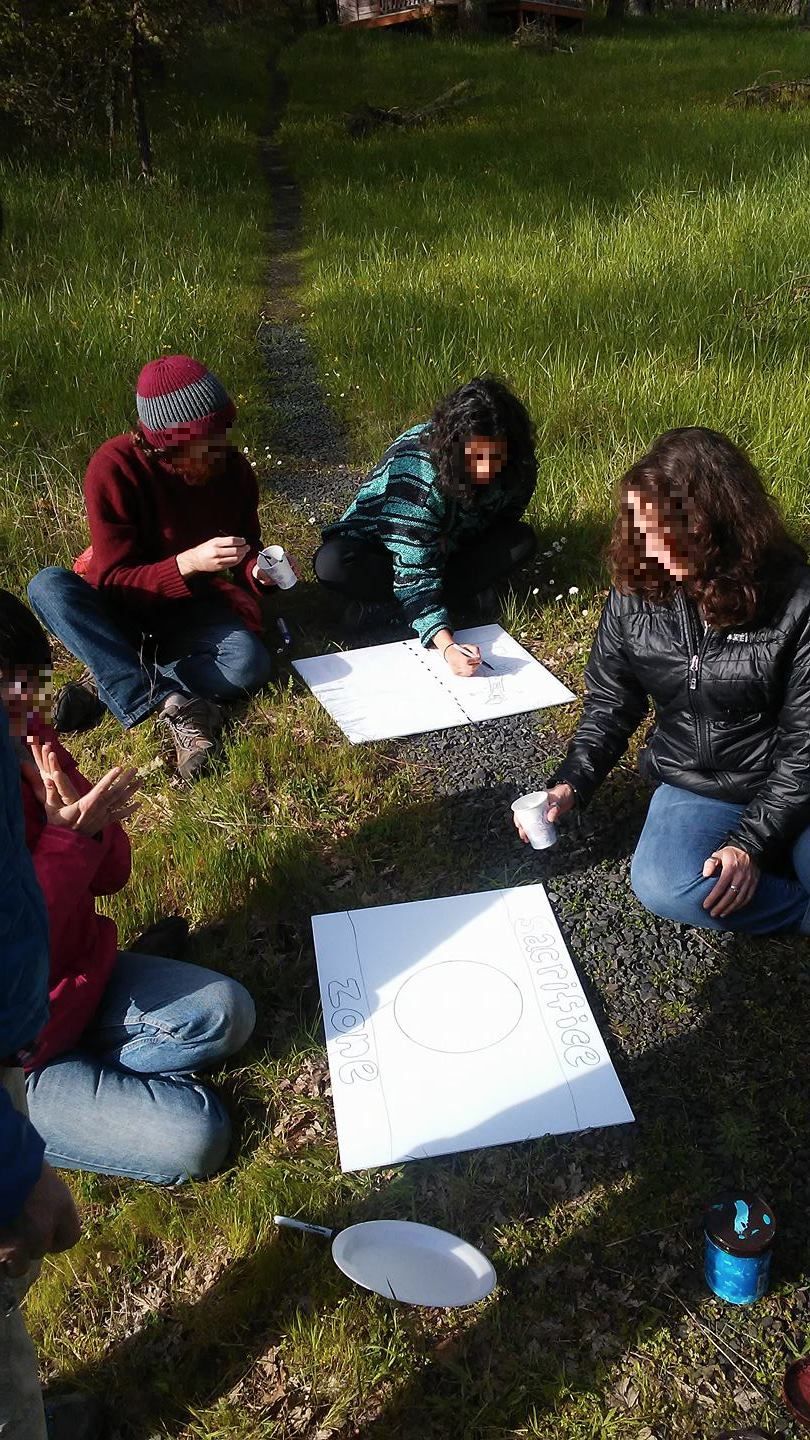
Artistic workshop after a long day sitting down inside.
“My daughter has been telling me for years about radical feminism and I never understood what she was talking about. I do now, somewhat, and I am aware of all I don’t know and hadn’t considered in terms of the climate crisis and potential steps I can take. I’m so glad I came.”
“I could spend weeks hearing and discussing the topics brought up on Saturday morning, and I learned a lot. The Privilege Walk was powerful and a great way to start the weekend. Thank you for the RadFem reading list and the matter-of-fact presentations on intersectional oppressions!”
“Awesome group of people at the training.”
“I’m home and full of inspiration… You have my deepest appreciation for the hours of hard work it took to make this weekend happen. The whole crew of you are simply wonderful, thank you for being dedicated enough to take bold actions and wise enough to do them prudently.”

Tripod and rope ascending workshop.
“The DA training offered an invaluable opportunity for DGR members and allies to meet in person, share ideas and skills, and build real community. Each new relationship felt like a door opening to our greater collective potential and previously unconsidered ideas. There is something magical in spending time together that cannot be quantified or explained. I can’t wait for the next get together and to see the inspiring ideas and actions that will surely come out of this training.”

by Deep Green Resistance News Service | Apr 29, 2017 | Education
by Max Wilbert / Deep Green Resistance Great Basin
As a kid, I pictured Nevada as a wasteland of sand and cacti. Today, I know better.
For the past five years, I’ve been packing up my truck every spring and taking a long day to drive to eastern Nevada to bask in the glory of one of the least densely-populated areas of the United States.
The broad valleys never fail to stun me, but most amazing are the mountains, limestone peaks arcing into the sky. Springs and creeks flowing from the hills support rich riparian zones and bring in birds and other wildlife from miles around. Antelope, deer, elk, and wild horses cross the valleys or stick to forested patches. This region is lush, biodiverse, and beautiful.
It’s also under threat. Across eastern Nevada, the Southern Nevada Water Authority seeks to build dozens of massive groundwater wells and pump almost every drop of water south to feed Las Vegas developments. The project has been a battle between locals and developers from Vegas for decades, and still drags on.
Another major threat is felling pinyon pine and juniper forests across not just this region, but the entire intermountain west. Ranchers have been doing this for decades to remove pesky trees getting in the way of their grass—and more importantly, their profit. As overgrazing continues to desertify Nevada—it’ll look like Iraq in another 100 years—removing trees allows ranchers to maintain the illusion that overstocking can continue indefinitely.
Countless people, including myself, are mobilizing to fight like hell for this land, this water, and these forests. We aim to stop these destructive projects by exposing their true nature and—if necessary—standing in their way.
There is a lot more to these stories, but I don’t have time to share it all here. Instead, I’d like to invite you to join myself and other community members, indigenous people, activists, ecologists, photographers, and families for the fifth annual Sacred Water, Sacred Forests Camp.
The camp takes place over Memorial Day weekend, May 27 to 29, near the town of Ely and Great Basin National Park. If you’re interested in attending, you can RSVP on the Facebook event page or by emailing greatbasin@deepgreenresistance.org.
I hope to be able to introduce you to this important, imperiled area in a few weeks.
—
Max Wilbert is a community organizer based in western Oregon who considers Nevada a second home.
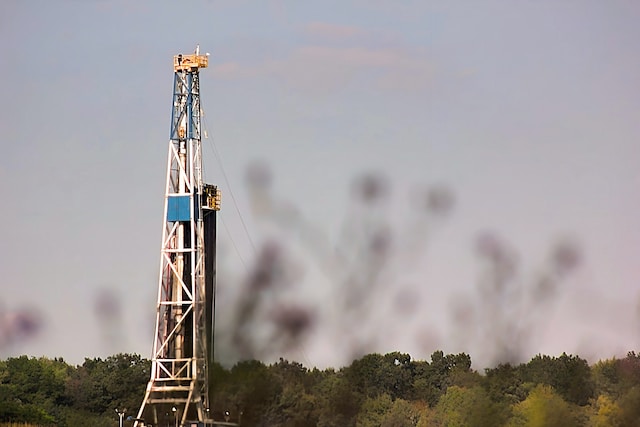
by Deep Green Resistance News Service | Apr 25, 2017 | Lobbying, NEWS
Featured image: Fracking well. The damage that causes earthquakes seems to occur after the drilling, when the wastewater is injected deep underground, stimulating existing fault lines. Indigenous and other communities want Colombia to join France, Germany, Scotland and Bulgaria in banning fracking. By Thinkstock.
by Rick Kearns / Indian Country Today Media Network
Fracking is coming to indigenous Colombian territories and other parts of the country, and activists are trying to halt the process.
The controversial process known as fracking, short for hydraulic fracturing, involves injecting water, sand and various chemicals at high pressure into subterranean rocks, so as to force open existing fissures and extract oil or gas.
Environmentalists, scientists and others around the world have asserted that fracking can contaminate surface water and subterranean aquifers and has been linked to earthquakes and low birth rates among other things. At least four countries – France, Germany, Scotland and Bulgaria – have banned fracking and other countries and regions are considering similar measures.
On March 22, close to 40 environmental organizations, trade unionists and land defenders known as the Alliance for a Colombia Free of Fracking sent a public letter to Colombian President Juan Manuel Santos, asking him to issue a moratorium on fracking due to it’s potential harm to the environment and to thousands of Indigenous and other Colombians living near the wells.
According to an April report, the Colombian government had granted 43 gas and oil concessions to various corporations including multinationals such as ExxonMobil. ConocoPhillips and Drummond Ltd.
The activists note in the letter that fracking has been associated with increased seismic activity. They point to a study showing how wastewater fracking wells in Oklahoma cause a dramatic increase: from 50 seismic events at a level of 3 in 2010 to 400 level 3 earthquakes in 2014, an 800 percent jump.
“And in terms of public health,” the Alliance letter continued, “there are studies from the U.S., Canada and the European Union that connect the proximity of people to the areas where fracking activities are carried out with cases of neural tube alterations (The neural tube is the structure in the embryo that ultimately forms the brain and spinal cord), births with low birth weight, other birth defects and an increase in the incidence of congential heart problems.”
The activists asserted that “there is evidence that emissions from wastewater fracking wells can travel through the air to residential zones where they can cause asthma…”
Some of the fracking areas overlap with Yupka, Wiwa and Wayuu territories and activists have noted that these projects would violate the land rights of these Indigenous Peoples and potentially others.
While none of these communities have issued press statements regarding fracking, two of the largest Indigenous organizations have identified the process as a serious problem in past reports.
In September of last year, the National Indigenous Organization of Colombia (ONIC) published a statement by the allied Association of Indigenous Councils of Northern Cauca (ACIN) about the peace process between the government and the FARC guerillas. In that statement they pointed out that the Indigenous communities were worried about the government’s policies involving “extractavism” and “fracking” and the lack of prior consultation of the communities which is against Colombian and international laws.
In response to the recent developments the Alliance group known as the Corporation for the Defense of Water, Territory and Ecosystems (CORDATEC) held a two day conference on April 19 and 20 on “The Social-Environmental Impact of Fracking” in an area already affected by gas exploration.
Among the panel topics at the conference were “Environmental Impact” and “Resistance and Social Conflicts.”
As of press time President Santos had not publicly responded to the letter from the Alliance.
Photo by Brad Weaver on Unsplash
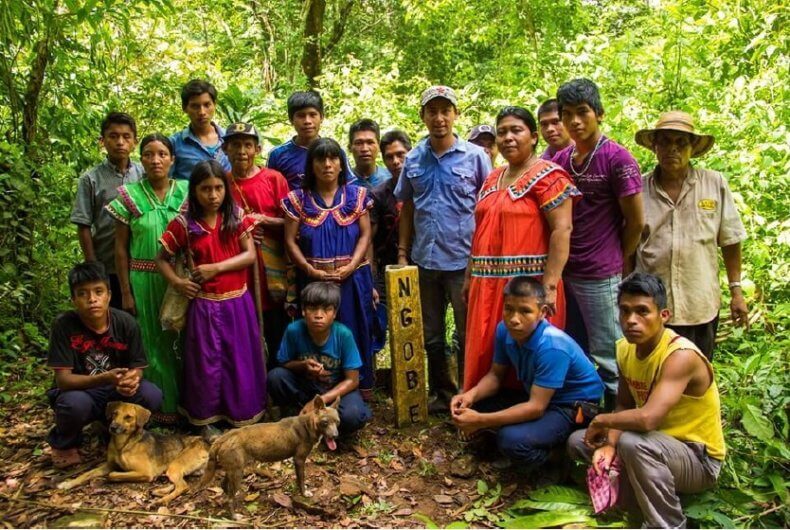
by Deep Green Resistance News Service | Apr 22, 2017 | Lobbying
Featured image: Residents of Kiad around an important boundary post for the Ngäbe people at the border of the comarca. (Photo courtesy Duiren Wagua)
Este artículo está disponible en español aquí
by Tracy Barnett / Intercontinental Cry
Cultural Community of Kiad, Panama — Members of the grassroots indigenous Ngäbe-Buglé group known as The April 10 Movement (El Movimiento 10 de Abril, or “M10”), issued a call to the international community on Wednesday. They ask for an intervention to stop Ngäbe-Buglé communities from being flooded by the Barro Blanco hydroelectric dam.
The M10 called the flooding illegal and a violation of their human rights and the UN Declaration on the Rights of Indigenous Peoples. They refer to an environmental impact statement that failed to acknowledge the presence of the three communities that would be flooded by the project. They also say the agreement that Panamanian President Juan Carlos Varela signed last August with the now-impeached leader Silvia Carrera was illegal, since it was done without the approval of the Ngäbe-Buglé General Congress, and was rejected by the congress in September.
Government representatives met with members of the group in the Cultural Community of Kiad on March 27. It was part of a series of meetings “to agree on options with respect to spaces and points of cultural veneration by communities impacted by the project and the monitoring of water quality studies,”[1] according to an institutional response from the government. Several days later, the water began to rise in the reservoir and has continued to rise until the time of publication of this communique. Community members have still not received communication from the government regarding the rising water levels or a future meeting date.
Communiqué from the April 10 Movement on the Barro Blanco hydroelectric plant
The community affected by the Hydroelectric Project Barro Blanco, hereby makes public the following facts of the violation of human rights by the Barro Blanco Dam:
1- As has been public knowledge since the beginning of the Barro Blanco project, the environmental impact study denied the existence of the original community that for centuries had lived in the confluence of the Tabasará River, and concessioning this place for the Barro Blanco hydroelectric dam has created a social, economic, cultural, spiritual, and environmental conflict for the community.
2- The government and the Supreme Court of Justice have violated the constitutional and legal precepts of our rights with the implementation of the Barro Blanco hydroelectric plant.
3- We firmly reject the ratification of the Varela-Carrera agreement for the defunct congress presided over by Demecio Case, held between 6 and 9 April 2017 in the northern community in the ñökribo region, in which agreement we played no part. Nor were we consulted about the content of the agreement, and the agreement was not accepted by the population of Llano Tugrí on August 22, 2016 and was rejected in Cerro Algodón on September 15, 2016 by the full General Congress where 148 delegates attended.
4- The highest body of expression and decision, the General Congress, has 255 elected delegates, with full right of decision and for which quorum constitutes 50% plus one; therefore the Norteño decision is illegal, since only 61 delegates attended, in addition to Mr. Demecio Case, who was removed from office on March 7, 2017, in Llano Tugrí, in the ordinary congress.
5- We request the President of the Republic to be a little more respectful of our rights, since any act carried out for the execution of said project has been done violating our legal security, and not only has violated the norms of the Republic, but also violated the Convention and the United Nations Declaration on the Rights of Indigenous Peoples.
6 – We call on the Panamanian population to protect the rights of all before the imposition of the government who makes use of economic and political power and interferes in the decision of the full Congress through the dismissal of Silvia Carrera and Demecio Case.
7- We make an urgent appeal to the national and international solidarity organizations and the United Nations to intervene to protect our rights as peoples most vulnerable to deserved justice in the Republic of Panama.
Gäejet Miranda
President of the M10 movement
Ngäbe-Büglé Comarca
Kiad Cultural Community, April 16, 2017
by Deep Green Resistance News Service | Apr 13, 2017 | Lobbying
by Center for Biological Diversity
TUCSON, Ariz.— The Center for Biological Diversity and Congressman Raúl M. Grijalva, who serves as ranking member of the House Committee on Natural Resources, today sued the Trump administration over the proposed border wall and other border security measures, calling on federal agencies to conduct an in-depth investigation of the proposal’s environmental impacts.
Today’s suit, filed in the U.S. District Court for the District of Arizona, is the first targeting the Trump administration’s plan to vastly expand and militarize the U.S.-Mexico border, including construction of a “great wall.”
“Trump’s border wall will divide and destroy the incredible communities and wild landscapes along the border,” said Kierán Suckling, the Center’s executive director.
“Endangered species like jaguars and ocelots don’t observe international boundaries and should not be sacrificed for unnecessary border militarization. Their survival and recovery depends on being able to move long distances across the landscape and repopulate places on both sides of the border where they’ve lived for thousands of years.”
The lawsuit seeks to require the U.S. Department of Homeland Security and U.S. Customs and Border Protection to prepare a supplemental “programmatic environmental impact statement” for the U.S.-Mexico border enforcement program.
The program includes Trump’s proposed wall as well as road construction, off-road vehicle patrols, installation of high-intensity lighting, construction of base camps and checkpoints, and other activities. These actions significantly impact the borderlands environment stretching from the Pacific Ocean to the Gulf of Mexico, which is home to millions of people, endangered species like jaguars and Mexican gray wolves, and protected federal lands like Big Bend National Park and Organ Pipe Cactus National Monument.
“American environmental laws are some of the oldest and strongest in the world, and they should apply to the borderlands just as they do everywhere else,” Grijalva said. “These laws exist to protect the health and well-being of our people, our wildlife, and the places they live. Trump’s wall — and his fanatical approach to our southern border — will do little more than perpetuate human suffering while irrevocably damaging our public lands and the wildlife that depend on them.”
Congressman Grijalva’s district is the largest Congressional district in Arizona and includes approximately 300 miles of the U.S./Mexico border.
If successful, today’s lawsuit would require the Trump administration to undertake a comprehensive review of the social, economic and environmental costs of the border wall.
Background
The National Environmental Policy Act requires that federal agencies conduct environmental review of a major federal action or program that significantly affects the quality of the human environment.
The Immigration and Naturalization Service — the precursor to the Department of Homeland Security — last updated the “programmatic environmental impact statement” for the U.S.-Mexico border enforcement program in 2001. That review identified the potential impacts of border enforcement operations, including limited border wall construction, on wildlife and endangered species in particular as a significant issue. The 2001 analysis was intended to be effective for five years but has never been updated.
In the 16 years since, the U.S.-Mexico border enforcement program and associated environmental impacts have expanded well beyond the predictions of that document, with deployment of thousands of new border agents, construction of hundreds of miles of border walls and fences, construction and reconstruction of thousands of miles of roads, installation of base camps and other military and security infrastructure, among numerous other actions.
During that same time, scientific understanding of the impacts of border walls and other border enforcement activities on wildlife and endangered species including jaguars, ocelots, Mexican gray wolves and cactus ferruginous pygmy owls has advanced significantly. The U.S. Fish and Wildlife Service has also designated “critical habitat” under the Endangered Species Act within 50 miles of the U.S.-Mexico border for more than 25 species since the outdated 2001 analysis was prepared.
Meanwhile, the number of undocumented migrants moving through the southwestern borderlands is at a historic low, and the border is more secure than it’s ever been.















